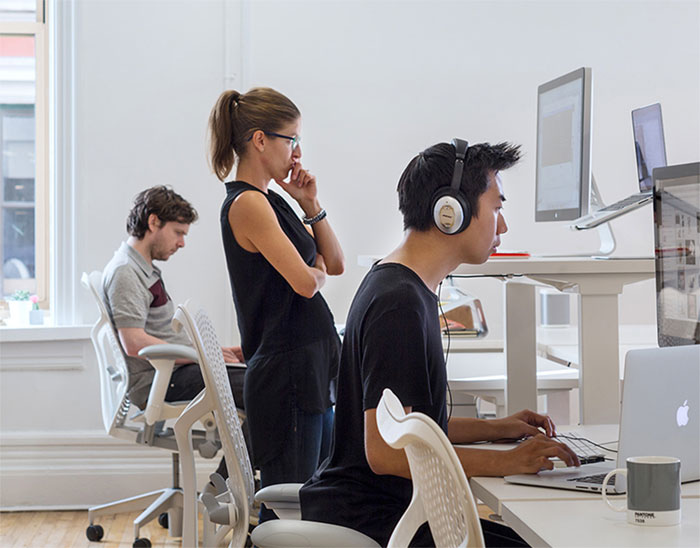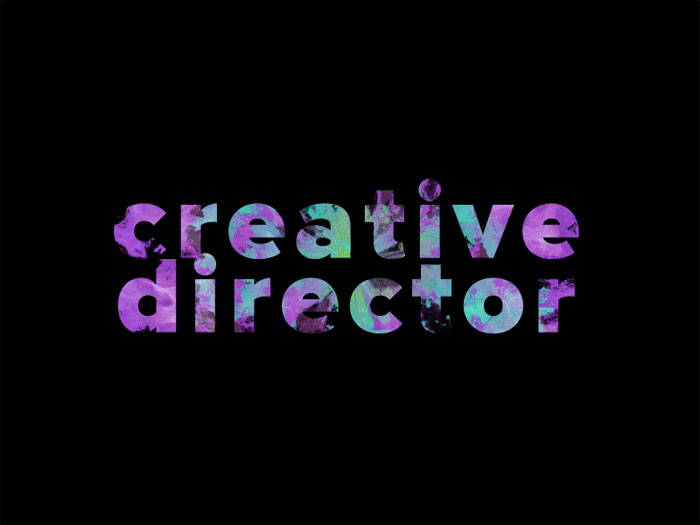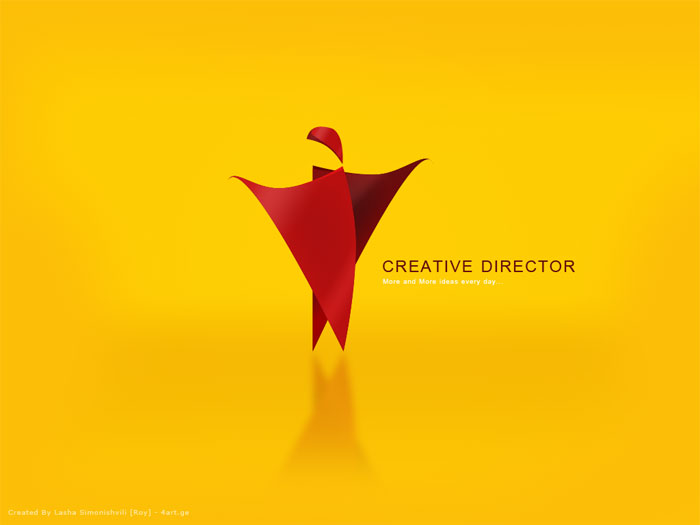A creative director fulfills a very important position for any project.
Many ad agencies employ creative directors to plan and help deliver a coherent strategic vision, as do companies that do their own in-house marketing.
What is a creative director? What does a creative director do? Creative directors are sometimes called design directors, as well. A creative director manages the creative staff. He or she will also oversee vendors, photographers, printers, and anyone else who is working on the project.
It’s the creative director who sets deadlines and keeps the project on track. They lead brainstorming sessions, assign projects, and help to clearly conceptualize ideas. They also usually speak with clients to make sure the project meets their needs. Often, the creative director has final creative authority.
The creative director role is more than just one that deals with personnel, however. The creative director works with account executives to make sure budget needs are met.
Another large part of the creative director job is the creation of proposals and the pitching of ideas. This means that anyone who is looking into how to become a creative director needs to have extensive knowledge of graphic fundamentals, print capabilities, web capabilities, and marketing principles the creative director job description is a wide-ranging one, including technical, artistic, and people skills.
Does this creative director definition appeal to you? If it does, let’s look into what it takes to become a creative director and what the creative director job is really like.
Creative Director Qualifications
A creative director resume is pretty extensive. Most creative directors have a degree in art, graphic design, communications, or some other related field. Many typically have 5 to 10 years of experience in design, project management, and/or brand development. This is not a job you just leap into. Most creative directors start out as graphic designers.
80% if advertising agency staff are graduates, according to the IPA Agency Census. Creative directors usually have a humanities degree, though an increasing number are coming from other backgrounds like management and technical roles.
This development is thanks to jobs like app developer, producer, and content strategist becoming routes to senior roles like creative director. This has made the already formidable competition for creative director jobs even more fearsome.
Work experience can tip the balance your way. Make a name for yourself and build a good reputation. Attend industry events to start networking in the industry. Run a good, well-read blog. Speak at industry events when you can.
These things will get you noticed by employers looking for a creative director. Some events to look into include Advertising Unlocked and workshops run by The National Advertising Benevolent Society (NABS). These events are geared to networking and newcomers.
If you impress them enough, but the position isn’t exactly open yet, you can find short-term placement. Try reaching out to an agency by sending them a CV and cover letter.
It’s really important to make it clear that you already know what you’re doing and that you’re staying up to date. Build your personal brand. Keep professional social media profiles and a blog that is updated on a regular basis. If you’re still a student, try taking on communications roles with clubs and societies offered at your school.
Skills a creative director needs:
- Great interpersonal skills and leadership abilities. You need to be able to inspire your creative team to give the project their all.
- Good written and verbal communication skills.
- Strong presentation skills so you can make amazing pitches to clients and senior employees.
- A creative mind.
- The ability to understand and conceptualize the vision of your clients.
- Up-to-date knowledge of current advertising and design trends.
- A self-starting attitude.
- An open outlook.
- The ability to hold under the pressure of looming deadlines.
- A thorough understanding of how creative roles work with other departments like data management and finance.
- Knowledge of software and applications that are used in the creative process
- Great skills in managing projects, people, and resources.
The top skills employers look for from a person seeking to fill a creative director position are:
- Experience. The most sought-after kinds of experience are experience in copywriting, art production, and design. If you have previous experience in demonstrating visionary expertise and success, be sure to highlight that on your creative director resume.
- Interpersonal skills. This is something that is looked for particularly during the interview process. Even if you have excellent technical knowledge and a lot of experience, a lack of interpersonal skills will result in you not getting the position.
- Leadership. Almost more than anything else, a creative director is a leader. Make sure you highlight any time when you demonstrated successful, competent leadership skills, especially under intense pressure.
- Market knowledge. Knowing the ins and out of marketing is vital for a creative director. Be sure to stay up to date on the latest trends and developments. Marketing is a fast-paced field and it can cost a lot if you fall behind.
Pursue Professional Development
A great way to develop the skills and reputation needed to be a creative director is to pursue professional development opportunities. Many of these opportunities are also great networking events.
A very easy to way to start this process is to follow industry trends by reading trade press publications. A quick morning web search over coffee can keep you up-to-date without too much work. There are also many mailing lists you can sign up for. Look for blogs run by top creative directors, as well.
Several employers and other organizations offer a variety of professional development schemes.
The IPA offers an MBA level IPA excellence Diploma. This program is targeted towards those with 3 to 5 years of experience in the industry who are looking to broaden their understanding of how brands work.
This increases value to clients. The IPA also offer short courses and seminars for people with the same experience level. The Communication Advertising and Marketing (CAM) Foundation offers a Diploma in Marketing Communications and a Diploma in Digital Marketing. Design and Art Direction (D&AD) also offer continuing professional development courses.
A good place to showcase your work and network is the annual CIM Marketing Excellence Awards.
Creative Director Salary
A starting creative director in the advertising field can expect to make between $30,000 and $40,000 a year. With some experience, that increases to between $57,000 and $85,000 a year. Highly experienced creative directors can earn over $114,000 depending on the size of their agency.
Like with any other kind of job, a creative director salary can vary by the size of the company they work for and their location. A lot of creative director jobs are full-time. Less than 20% of the staff are freelancers. This is a higher number in marketing and editorial positions.
Creative Director Hours and Working Conditions

A creative director typically works an 8 hour day, from 9 AM to 5 PM. However, evening networking events are also a big factor. A creative director is expected to be extremely dedicated, and those 8 hours can grow much longer on major campaign or when deadlines are looming. Paid overtime isn’t very common, though how your company manages overtime can vary significantly.
Expect to be juggling multiple projects and some pretty tight deadlines. Creative direction is a high-pressure job. You have to make sure you stay on the cutting edge of technical innovations and learn how to become competent with them very quickly.
You’ll usually be working in an office, but you will also spend a fair amount of time out of it at networking events, exhibitions, and industry events. Networking events are frequently in pleasant venues. Travel during the work week is very common, as is overnight absence from home.
The longer you work as a creative director, the more likely you’ll get the chance to travel internationally. Travel in this job often includes all expenses paid accommodations and transportation. Hotels are often located in nice areas, especially for industry events and exhibitions.
As a creative director, you will still get changes to add to your own creative portfolio. This is a great opportunity to create new visions and affect the course of your field’s history. It’s considered a major perk by those who already work as creative directors. You will get the opportunity to work on new, innovative projects almost every day.
The environment is usually dynamic, young, and multicultural. The attitude is generally “work hard play hard”. Often, you’ll be able to dress down even at the office. You and your team will be pushing hard, but the amount of satisfaction you’ll feel when you complete a project will be immense, especially if it’s one that you’ll see on billboard, television, or elsewhere outside of work.
Employers

Creative directors are employed at ad agencies and the marketing departments of large companies. Every individual employer manages their recruitment on their own. They tend to have their graduate recruitment schemes with applications at the start of the final year of study. If you want to do this, know that competition is fierce, so apply early.
A lot of graduates start out in the marketing and advertising fields through internships. This is an opportunity to gain valuable experience, build a reputation, and create a network of contacts. After you have these, you might have the chance to do freelance work.
Go to networking events and submit speculative applications followed up by informal face-to-face meetings. These are well-established ways to find new opportunities, especially if you’re seeking a senior role.
A few companies and agencies to keep an eye on are AdMission, Campaign. Chartered Institute of Marketing (CIM), Institute for Practitioners in Advertising (IPA), and The Drum. If you’re a student, you should also check your university’s careers service vacancy lists and websites.
Continuing Opportunities
There’s plenty of room to grow as a creative director. If you manage to secure a creative director job, look to capitalize on international prospects or even set up your own agency by working with a finance director and chief executive.
You have the opportunity to become the regional head of agency. This is a great chance to reinvigorate with established or emerging markets. The UK is still seen as the center of advertising excellence.
As a result, a lot of business in the industry is done in English. Singapore is the hub for Asia, but Shanghai is growing. In the United States, San Francisco and New York are the two advertising hubs.
If you work in marketing, you can become a chief marketing officer (CMO). If you continue in that position, the door to becoming a chief executive offer (CEO) may open up to you. In editorial positions, it’s possible to become the creative director across the whole publishing group.
How to Be a Creative Director
Responsibilities
- You will need to build a creative environment for your team.
- You will oversee the ideas and projects of the team you manage.
- You will be responsible for the creative philosophy of the team and their standard of creative output.
- You will have to develop ideas for promotional and advertising campaigns.
- You will have to pitch concept to clients outside of your agency or directors in the company.
- You will oversee several projects from start to finish, often at the same time.
- You will be responsible for holding your team to deadlines.
- You will be responsible for signing off on all projects before they are presented.
- You will need to understand the commercial elements of your marketing department or agency.
- You will be responsible for hiring new members of creative team.
- You will need to manage all conflicts and issues within your team.
Things Great Creative Directors Do
Set clear creative standards and objectives
Everyone in the team needs to have clear understanding of what’s expected of them. A great creative director sets the bar high. You need to make the standards easy to understand for everyone. Include examples if you can. This is especially important if you’re trying to effect change and increase the work of an already existing project or team.
Be accessible and approachable
New bosses always make people anxious. Your team will be eager to learn who you are, how you think, and what you’re about. Make yourself easy to reach. Be courteous and listen to what your team has to say.
Learn what your team thinks about their work
Your team is doing a lot of the heavy lifting day-to-day. Ask what they think of their work. Solicit their suggestions. They’ll appreciate the fact that you’re listening. You’ll get a better understanding of whether or not they have the same standards as you do. Also, you might find they have some great ideas, approaches, and solutions.
Develop a culture of honest engagement
Allow everyone at all levels to be able to speak their minds, offer up ideas, or express options about the projects. You will be the one making all final decisions, which is something everyone knows, but your team will feel much better if they can be honest. This is a major contribution to a better, more productive workplace culture.
Provide specific and constructive reviews
Don’t be vague when you’re doing your reviews/ “This is just not doing it for me” is unhelpful feedback. Anyone can say it. Your team is likely to assume you don’t really care or that you may not have even reviewed their submission. Give them feedback they can use. Why is this not working? Is there a good idea somewhere in there?
Find it if there is. If there isn’t, offer suggestions about new approaches and directions. This will provide the team with real direction to go in. No one enjoys guessing games, especially not from their boss. This is also a great chance to help team members improve their skills.
Do some of the work yourself
Don’t make yourself into competition for your team, but give a helping hand. Avoid taking the plum assignments. If you can demonstrate your own skills and firsthand knowledge, your team will have more respect for you. Make sure you put in your best effort into any part of the work you take on.
Offer people a fair chance, but get rid of nonproductive team members
Creative departments depend on talent. You’re only as good as your least talented individual. Be fair, but if someone isn’t pulling their weight, you need to let them go. This is hard, but it is necessary. You owe it your clients and the rest of the team to only keep the best people for the job around.
Hire people who are better than you
Creative directors don’t have time or energy to be insecure. Hire choice talent. Don’t be afraid of being shown up, even if that person works in the same area that you did at that level. You’re only as good as your talent, so pick the best talent for your team.
Be able to save the day but avoid doing so
Don’t rush in to save the team at the last moment. Stay invested enough to be able to solve it, but try to avoid needing to. Your team is often more capable than you know so offer them the chance to come up with solutions. Just make sure you can be there if you need to.
Take the blame, but distribute the credit
Stand behind work that you’ve approved. If it doesn’t go over well, take the blamed on your own shoulders. If it’s a success, give credit where it’s due: your team. Push yourself to the background. Your team will notice this and appreciate it- -and so will your management, so don’t worry.
Spend the extra time to make good into great
Don’t waste your time producing so-so work. That’s a waste of everyone’s time and money. Instead, push good work into great work. It usually only takes a little tweaking and polish. It is well worth the effort, especially when compared to pushing okay work into becoming more okay work. It’s still not great.
Create healthy competition
Competition can be very good for a work environment. However, you don’t want to turn your team into a distrustful pack of people who are looking only to outshine the rest. Having a shootout for every assignment is incredibly demoralizing. Friendly rivalries, however, are a good thing and will improve the quality of the team’s output.
Keep out of the way
Make sure to give your team their space. Lay out your standards and objectives, then leave them to it. They’ll appreciate the trust you’re putting in their work ethic and skills. If you remember to remain approachable and accessible, they’ll find you when they need you. Hold them accountable, of course, but don’t act like you don’t trust them.
Remember that everyone is different
You’re not running a team of robots. Trying to fit a person to a job is a mistake. Instead, fit the job to a person’s strengths and abilities. You run a team of individuals. Figure out how your team works so you can place people in the best position for their talents.
Don’t accept chaos as the standard
Many creative departments like to let the messiness and chaos of the process take everything over. They use that fact as a shield to hide form managing it. This all too often results in delayed briefs, last-minute changes, and suddenly added deadlines. It takes some planning to avoid this and not all that much planning, either.
Have an awesome creative manager
Hire and keep a creative manager who has a good understanding of the organization, team assignments, scheduling, and so on. Build a good rapport with this person. Your job shouldn’t become an administrative swamp. You need to be able to focus on the ideas, work, and execution.
Avoid burning people out
Allow people time off and vacations when you can. People need to get away from work and recharge from time to time, otherwise, they come to hate their work and begin to lose inspiration. Pay attention to how well your team is doing. Your timeline might not allow for a vacation period now, but it is something you can plan for the future. Don’t let today’s deadline destroy future projects.
Be kind
Creative people can be emotionally fragile. Everyone, creative or otherwise, is a combo of bravado and insecurity. Be gentle with your team. Offer them a lot of your time. Generously praise them when they deserve it.
Develop your own creative side
It’s easy to lose sight of your own creative side when you’re a creative director. You’ve got a dozen irons in the fire and you are constantly dealing with the creative side of your team members.
Don’t abandon your own creative thinking, though! You don’t have to go honing your skills at a software program, but just thinking about what people like the way something looks. Figure out why a certain thing looks good for its target audience. This will make you a better creative director and keep you from losing what probably got you into this field in the first place.
Always be innovating
Look at ways to improve on existing material. Play with new ideas in your mind. See if you can tweak something to make it even more appealing. See if new trends in technology can be used to make an existing design even better than it already is.
Keep the project in line with company values and culture
A creative director has a broader view of projects than many who work in their department. The work that comes from your team should not only look good, it should also convey your organization’s values and ideals. If you’re developing something for a client, make sure it works for their values, as well.
Stay on-brand
While making sure project fit within brand guidelines can be boring, it’s a vital aspect of being a creative director. Doing so will make sure that the brand never lets things up. The quality should be high. In the modern world, slapdash and cheap work simply is not going to work for any serious company.
Be adaptable
No project is going to go smoothly. Schedules shift, emergencies happen, new requirements are suddenly thrown in. Remain flexible. This will help mitigate not only your own stress but also that of your team. Lead by example when things go awry and show them that it’s not the end of the world. You guys have this.
Create the right environment
While your team does have deadlines to meet, make sure you aren’t turning your department into a sweatshop. Most creative people work better in a relaxed environment with some guiding discipline. Figure out if your team works better in an open floor plan or with their own more-closed sections. Everything should be organized but comfortable.
Keep up with trends and developments
When you’re deep in the heart of a project, it can be hard to stay aware of how the industry is changing. Don’t let that part of your professional development fall by the wayside. Stay aware of how things are changing and what’s coming over the horizon. As consuming as your current work may be now, this project will end you will have a new one to work on soon enough.
Don’t mind being hated
Learn that sometimes your team will hate your guts. Get over it before it happens. You’re there to make sure the project is completed.
Deadline crunches are hard on everyone and are often the time when you’ll find that people hate you the most, in part because they might blame you for the situation and in part because tensions are high. Don’t let your fear of being disliked make you an average creative director.
Remember to keep a good work-life balance
You might love your job, your team, and your project, but don’t let it consume your entire existence. If you have a family, that can be really hard on them. It’s also not good for you or your career.
Letting work consume everything will cause you to lose perspective, which is something that a creative director always needs to keep in mind. You might also lose your love for your work and your own sense of creative inspiration. Remember to let go of work and just relax on occasion.
Take care of your people
Prevent bad things from happening to great ideas…and talented people. This is a behind-the-scenes aspect of being a creative director. Often, the people you’re taking care of won’t even know what you’ve done for them, which is a good thing.
Be quiet
You need to trust in the skills and knowledge of your team. Let them do their work. Offer your input when it’s asked for and when you review projects. Build trust with your team. Many of them will be much younger than you.
They want their ideas approved and published. Don’t force a hyper-detailed vision on them. Often, this isn’t what your client wants. They want exciting, fresh ideas, not older ones that everyone has seen before. Be quiet and let your creative team do their thing.
Listen to your clients
You may work for an agency, but at the end of the day, the client is the one really providing direction to the project. Listen to them. Do it for hours if you need to. Ask smart questions and design the project around their wants and needs.
Offer your expert advice on problems and ideas. Clients are liable to come to you with spreadsheets and PowerPoints and presentations. Listen and look at all of it. The spark you need to focus on is buried somewhere in there.
Believe in your project
You’re very likely going to be the one presenting the finished project. Believe in it fully. Communicate that belief to everyone in the room. If you have to fight for what you think is a good decision, do so with respect. At this point, you should have carefully chosen and approved every aspect of the project.
Ending thoughts on becoming a creative director
Creative direction is an exciting and lucrative field. Getting one of this coveted position requires a lot of work, but once there, you and your team can make your mark on the world.
If you liked this article about becoming a creative director, you should like these as well:
- What is UI Design: User Interface Design Fundamentals
- A Guide To Usable Portfolio Websites For Digital Designers & Creatives
- Graphic Design Interview Questions You Should Know Answers To
The post Creative Director: Job Description, Salary, And How To Become One appeared first on Design your way.
Source: https://ift.tt/2IoIoZl





No comments:
Post a Comment